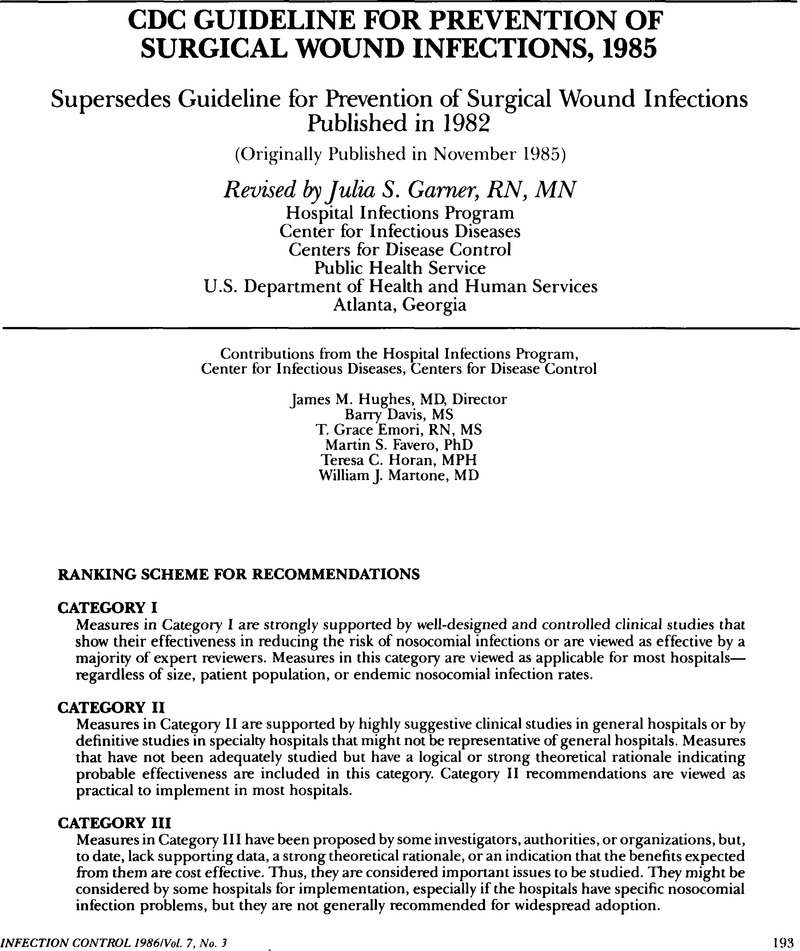Crossref Citations
This article has been cited by the following publications. This list is generated based on data provided by Crossref.
Robicsek, Francis
1986.
The Economy of Perioperative Infections in Cardiac Surgery.
The Annals of Thoracic Surgery,
Vol. 42,
Issue. 3,
p.
233.
Hughes, J. M.
1987.
Setting priorities: Nationwide nosocomial infection prevention and control programs in the USA.
European Journal of Clinical Microbiology,
Vol. 6,
Issue. 3,
p.
348.
Bergan, Tom
and
Nord, Carl Erik
1989.
Antimicrobial Prophylaxis: Proceedings of the Symposium on Antimicrobial Prophylaxis. Oslo, May 4–5, 1990.
Scandinavian Journal of Infectious Diseases,
Vol. 21,
Issue. sup70,
p.
1.
Mertens, R.
Verbist, L.
Gordts, B.
Lauwers, S.
Potvliege, C.
Reybrouck, G.
Verschraegen, G.
Wauters, G.
Berghmans, L.
Dondeyne, F.
and
Stroobant, A.
1989.
National study on the utilization of prophylactic antibiotics in surgery, Belgium, 1986.
Epidemiology and Infection,
Vol. 103,
Issue. 2,
p.
311.
O'Neale, Mary
1989.
Requirements for temperature and humidity levels and air exchanges in the OR; definition of implants.
AORN Journal,
Vol. 49,
Issue. 3,
p.
734.
Leyden, J. J.
McGinley, K. J.
Kates, S. G.
and
Myung, K. B.
1989.
Subungual Bacteria of the Hand: Contribution to the Glove Juice Test; Efficacy of Antimicrobial Detergents.
Infection Control and Hospital Epidemiology,
Vol. 10,
Issue. 10,
p.
451.
Schiff, Frank S
1990.
The Shouting Surgeon as a Possible Source of Endophthalmitis.
Ophthalmic Surgery, Lasers and Imaging Retina,
Vol. 21,
Issue. 6,
p.
438.
Springthorpe, V. Susan
and
Sattar, Syed A.
1990.
Chemical disinfection of virus‐contaminated surfaces.
Critical Reviews in Environmental Control,
Vol. 20,
Issue. 3,
p.
169.
Goldmann, Donald A.
1991.
Contemporary challenges for hospital epidemiology.
The American Journal of Medicine,
Vol. 91,
Issue. 3,
p.
S8.
Carrau, Ricardo L.
Snyderman, Carl
Janecka, Ivo P.
Sekhar, Laligam
Sen, Chandra
and
D'Amico, Frank
1991.
Antibiotic prophylaxis in cranial base surgery.
Head & Neck,
Vol. 13,
Issue. 4,
p.
311.
Reid, A. Bruce
and
Stranc, Miroslaw F.
1991.
Healing of infected wounds following Iodine scrub or CO2 laser treatment.
Lasers in Surgery and Medicine,
Vol. 11,
Issue. 5,
p.
475.
Rehork, B.
and
Rüden, H.
1991.
Investigations into the efficacy of different procedures for surgical hand disinfection between consecutive operations.
Journal of Hospital Infection,
Vol. 19,
Issue. 2,
p.
115.
Culver, David H.
Horan, Teresa C.
Gaynes, Robert P.
Martone, William J.
Jarvis, William R.
Emori, T.Grace
Banerjee, Shailen N.
Edwards, Jonathan R.
Tolson, James S.
Henderson, Tonya S.
and
Hughes, James M.
1991.
Surgical wound infection rates by wound class, operative procedure, and patient risk index.
The American Journal of Medicine,
Vol. 91,
Issue. 3,
p.
S152.
Lovitt, Shelly A.
Nichols, Ronald Lee
Smith, Jeffrey W.
Muzik, Anita C.
and
Pearce, Patricia F.
1992.
Isolation gowns: A false sense of security?.
American Journal of Infection Control,
Vol. 20,
Issue. 4,
p.
185.
Winston, Ken R.
1992.
Hair and Neurosurgery.
Neurosurgery,
Vol. 31,
Issue. 2,
p.
320.
Beck-Sague, Consuelo M.
Chong, Wang H.
Roy, Connie
Anderson, Roger
and
Jarvis, William R
1992.
Outbreak of Surgical Wound Infections Associated With Total Hip Arthroplasty.
Infection Control & Hospital Epidemiology,
Vol. 13,
Issue. 9,
p.
526.
Winston, Ken R.
1992.
Hair and Neurosurgery.
Neurosurgery,
Vol. 31,
Issue. 2,
p.
320???329.
Beck-Sague, Consuelo M.
Chong, Wang H.
Roy, Connie
Anderson, Roger
and
Jarvis, William R
1992.
Outbreak of Surgical Wound Infections Associated With Total Hip Arthroplasty.
Infection Control & Hospital Epidemiology,
Vol. 13,
Issue. 9,
p.
526.
Emori, T G
and
Gaynes, R P
1993.
An overview of nosocomial infections, including the role of the microbiology laboratory.
Clinical Microbiology Reviews,
Vol. 6,
Issue. 4,
p.
428.
Edmond, Michael B.
and
Wenzel, Richard P.
1993.
Ethical Considerations in the Use of Subliminal Stimulation to Improve Handwashing Compliance: Scientific Utility versus Autonomy of the Individual.
Infection Control and Hospital Epidemiology,
Vol. 14,
Issue. 2,
p.
107.



